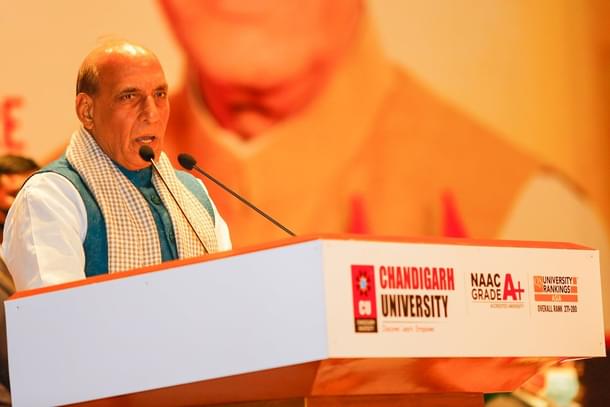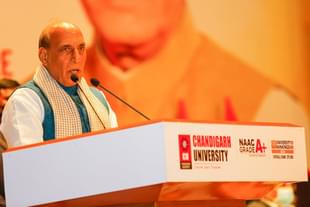News Headlines
Rajnath Singh Inaugurates Kalpana Chawla Centre For Research In Space Science And Technology At Chandigarh University
Swarajya Staff
Jan 04, 2022, 09:16 AM | Updated 11:54 AM IST
Save & read from anywhere!
Bookmark stories for easy access on any device or the Swarajya app.


Defence Minister Rajnath Singh inaugurated Kalpana Chawla Centre for Research in Space Science and Technology (KCCRSST) at Chandigarh University on Monday (3 January).
He also launched a Scholarship Scheme, worth Rs 10 crore, for the wards of Defence Personnel of the three Services.
Established with the objective of training students in space science, satellite development and meet future challenges in space research, the state-of-the-art KCCRSST would be the Ground Control Station for the Chandigarh University's Student Satellite (CUSat), an in-house developed nano-satellite being designed by the students of the university and a Geo-Spatial Centre for research, besides other projects, a Defence Ministry release said on Monday.
The CUSat will be among the 75 student-built satellites to be launched into space on the eve of the 75thIndependence Day in 2022.
The Chandigarh University has joined the list of 13 institutes like Indian Institute of Technology (IIT) Kanpur, IIT Bombay and became the first university in North India to design and develop its own satellite.
For the project, 75 students of the University have been working on the Chandigarh University Student Satellite Project under the guidance of eminent Indian scientists.
With the launch of CUSat, Punjab will become the first border state in India to have its own satellite in space.
The launch of the university's nanosatellite - CUSat will prove to be an important step for the country, as it will collect data related to border intrusion detection, agriculture, weather forecasting, natural disaster forecasting, which will be helpful in research and study of various problems in these areas.
In addition, the GCS will help develop satellite research facilities and launch satellites in countries that do not have developed satellite technology.
In his address, Rajnath Singh described the establishment of the Research Centre as an important step towards strengthening the space sector of the country by stressing that it is only through these efforts that India can become a leader in future technologies.
Remembering late India-born astronaut Kalpana Chawla, Rajnath Singh described her as a symbol of women empowerment, who took a flight beyond imagination.
He urged the people to maintain her zeal and enthusiasm and motivate their daughters to go ahead and touch unimaginable heights.
He likened the KCCRSST with ‘pride of India’ Kalpana Chawla, hoping that this research facility would touch new heights of success, similar to the remarkable achievements of the late India-born astronaut who brought universal recognition to her country of origin, the ministry said.
“In the 21st century, the future of India can be secured only when you have a gleam in your eyes to reach the stars and planets. More Indians like Aryabhatta, Vikram Sarabhai, Satish Dhawan and Kalpana Chawla will emerge from amongst you all if you eye different planets and constellations,” the Defence Minister told the students present on the occasion.
Singh called for an active and long-term public-private partnership to take the education and science sectors to a global level and make India a knowledge economy.
“Today, the private sector is exposed to a large number of opportunities in the space sector. Whether it is defence or space, we are fully welcoming the private sector,” he said, reiterating the government’s commitment of strengthening the private sector for the holistic development of the Nation.
On the setting up of Indian National Space Promotion and Authorisation Centre (IN-SPACe), he said, the independent agency will act as a single window for matters related to the space sector.
The Defence Minister added that the Government is laying special emphasis on promoting the use of space-based applications through every sector.
Use of geo-tagging for roads and other infrastructure in villages, monitoring of development works in remote areas through satellite imagery, and identifying problems related to crops and fields for farmers is helping the government in many ways, he added.





